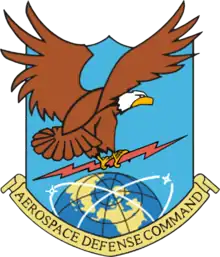Pittsburgh International Airport
Pittsburgh International Airport (IATA: PIT, ICAO: KPIT, FAA LID: PIT), formerly Greater Pittsburgh International Airport, is a civil–military international airport in Findlay Township and Moon Township, Pennsylvania. It is the primary international airport serving the Greater Pittsburgh Region, located about 10 miles (15 km) west of downtown Pittsburgh, at an elevation of 1,202 feet (366 m) above sea level.
Pittsburgh International Airport | |||||||||||||||||||||||
|---|---|---|---|---|---|---|---|---|---|---|---|---|---|---|---|---|---|---|---|---|---|---|---|
 | |||||||||||||||||||||||
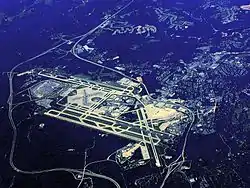 | |||||||||||||||||||||||
| Summary | |||||||||||||||||||||||
| Airport type | Public / military | ||||||||||||||||||||||
| Owner | Allegheny County | ||||||||||||||||||||||
| Operator | Allegheny County Airport Authority | ||||||||||||||||||||||
| Serves | Pittsburgh, Pennsylvania | ||||||||||||||||||||||
| Location | Findlay Township and Moon Township, Pennsylvania, U.S. | ||||||||||||||||||||||
| Hub for | Southern Airways Express[1] Wiggins Airways | ||||||||||||||||||||||
| Focus city for | |||||||||||||||||||||||
| Elevation AMSL | 1,202 ft / 366 m | ||||||||||||||||||||||
| Coordinates | 40.496°N 80.246°W | ||||||||||||||||||||||
| Website | FlyPittsburgh.com | ||||||||||||||||||||||
| Maps | |||||||||||||||||||||||
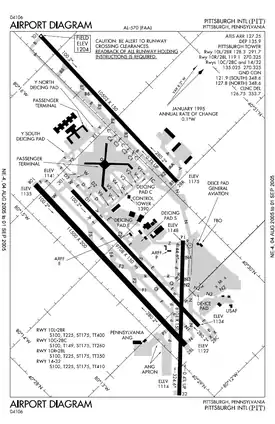 FAA Airport Diagram | |||||||||||||||||||||||
 PIT Location of airport in Pennsylvania  PIT PIT (the United States) | |||||||||||||||||||||||
| Runways | |||||||||||||||||||||||
| |||||||||||||||||||||||
| Helipads | |||||||||||||||||||||||
| |||||||||||||||||||||||
| Statistics (2020) | |||||||||||||||||||||||
| |||||||||||||||||||||||
First opened in 1952, the airport was initially served by five airlines and became a small hub for Trans World Airlines for over two decades. The airport underwent a massive $1 billion rebuilding and expansion which was completed in 1992 and became a major hub for US Airways. The new airport was one of the most innovative in the world, dubbed the "airport of the future" by the New York Times,[6] and helped to pioneer modern airport design with its X-shape to reduce distance between gates, underground tram to transport passengers around the airport, and array of shopping options, all of which were cutting-edge at the time.[7][8]
Traffic peaked at 20 million passengers in the late 1990s, but US Airways, which was facing bankruptcy, abandoned it as a hub in 2004, eliminating thousands of jobs and nearly bankrupting the airport itself, which was built largely to suit US Airways' needs.[9][10] The airport experienced a resurgence in the 2010s, doubling the number of carriers to 16 as the Allegheny County Airport Authority has aggressively courted airlines and lobbied for new routes.[9] In 2017, the airport reopened access to the post-security terminal for passengers who are not flying, as long as they can pass through security, becoming the first airport in the country to do so after the federal government lifted restrictions put in place after 9/11.[11]
Southwest Airlines is currently the airport's top carrier by market share. The airport is a maintenance base for American Airlines.[12]
In 2017, local officials unveiled plans for a $1.1 billion renovation[13] which will include a new terminal for check-in, security, and baggage claim adjacent to the gates.[14][15] The project was delayed due to the coronavirus pandemic. It is now projected to open in 2025.[16]
Pittsburgh International Airport is the busiest airport in western Pennsylvania and the second-busiest airport in the state, after Philadelphia International Airport. In 2019 it served 9.78 million passengers, the highest rate since 2007. Traffic dropped to 3.65 million passengers in 2020 due to the COVID-19 pandemic.
Overview
The airport is encircled by I-376 and Business Loop 376, which is the main access for Airport Cargo and Servicing as well as other flight industries. It is owned by the county and operated by the Allegheny County Airport Authority, which also operates the Allegheny County Airport. PIT is primarily a passenger airport serving the Pittsburgh metropolitan area with an average of 414 flights per day to 74 destinations on 17 airlines.[17] It also is the home of Pittsburgh Air Reserve Station, a combined facility of the Air Force Reserve Command and the Air National Guard, providing aerial refueling, air mobility and tactical airlift support to the U.S. Air Force and other U.S. Department of Defense activities. The airport also has an air cargo facility and supports general aviation operations.
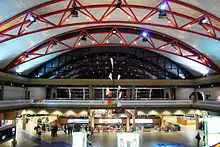
PIT is the second-busiest passenger airport in Pennsylvania and 47th-busiest in the United States, serving 8,128,187 passengers in 2015. The airport has the second longest runway of a commercial airport in Pennsylvania at 11,500 feet (3,500 m); Philadelphia International Airport's longest runway is 12,000 feet in length. It also undertook numerous renovations of facilities in the late 20th century to accommodate increased passenger traffic, upgrading the terminal. Until 2004, US Airways' second largest hub was at PIT. In 2010, the airline remained PIT's largest carrier (handling 26 percent[18] of passengers). On October 17, 2015, US Airways merged with American Airlines to become the world's largest airline. The new American Airlines uses fifteen gates, more than any other airline at PIT.
The airport has international flights to Canada and Mexico. Nonstop transatlantic flights resumed on June 3, 2009, when Delta Air Lines began flights to Paris.[19] This service ended in September 2018.[20] Other international destinations include Toronto and Montreal in Canada; and Cancún, Mexico.
PIT occupies 10,000 acres (40.5 km2).[3]
The Official Airline Guide Worldwide listed PIT on its short list of the world's best airports for four consecutive years. The market research leader, JD Power and Associates, named PIT among the top five airports in its two most recent customer satisfaction surveys. Conde Nast Traveler's Magazine ranked PIT as the best in 1999 in the United States[21] and third in the world in its 2000 People's Choice Awards. In 2011 Conde Nast Traveler ranked the facility as the 7th best for business travelers.[22]
History
Early years
Until the beginning of World War II, Moon Township was mostly a rural agricultural area. It was not considered a suburb of downtown Pittsburgh as it was too distant. It was served solely by Pittsburgh-based state and federal services and media. In the early 1920s John A. Bell of Carnegie purchased a number of small farms in Moon and established a commercial dairy farm on his 1,900 acres (8 km2) of land. He was bought out by E.E. Rieck and his wife, and C.F. Nettrour, owners of the established Rieck's Dairy. They doubled the number of cattle at the farm.
Around 1940 the federal government, through the Works Progress Administration (WPA), determined that the Pittsburgh area needed a military airport to defend the industrial wealth of the area and to provide a training base and stop-over facility. The administration of President Franklin D. Roosevelt was continuing to invest in infrastructure across the country in the waning years of the Great Depression, before the US entered World War II, which had started in 1939. The agricultural expanses of Moon Township were attractive to airport planners in the city. The Civil Aeronautics Administration proposed $2.6 million to the county for a $6 million field in August 1941 ($45.2 million and $104 million present day dollars).[23] The county bought the Bell Farm, and federal agencies began construction of the runways on April 20, 1942, after the US had entered the war.
In 1944 Allegheny County officials proposed to expand the military airport with the addition of a commercial passenger terminal to relieve the Allegheny County Airport, which was built in 1926 and was becoming too small. Ground was broken on the new passenger terminal on July 18, 1946. The new terminal would eventually cost $33 million ($318 million present day dollars) and was built entirely by Pittsburgh-area companies. The new airport, christened as Greater Pittsburgh Airport (renamed Greater Pittsburgh International Airport in 1972 upon the opening of the International Arrivals Building) opened on May 31, 1952. The first flight was on June 3, 1952. In its full year of operation in 1953, more than 1.4 million passengers used the terminal. "Greater Pitt" was then considered modern and spacious. The airport terminal was the largest in the United States, second only to Idlewild Airport's (now JFK Airport) in New York when it was completed five years later.[24][25] The airport's capacity is one of its most valuable assets.

The airport was designed by local architect Joseph W. Hoover. One of the features of his style is the use of simple, exposed concrete, steel, and glass materials. The terminal building was constructed in "stepped" levels: the first floor extended farther than the second, the second floor extended farther than the third, etc. Such a design meant that the uncovered roof of the lower level could be an observation deck. In addition to the observation decks, the rounded "Horizon Room" was on the fourth floor with a commanding view of the airport. The interior of the terminal building was in the contemporary International Style, as was the exterior. One of the memorable features of the lobby was the large compass laid in the floor with green and yellow-orange terrazzo. A mobile by Alexander Calder was another decorative feature of the lobby. The mobile hangs in the center core of the new airside terminal. A re-creation of the compass was installed in the new terminal at an exhibit dedicated to old "Greater Pitt".
Growth and hub years
The first five airlines of the Greater Pittsburgh Airport were TWA, Capital Airlines (later part of United), Northwest, All American (later Allegheny Airlines, then USAir, and finally US Airways), and Eastern Airlines. The April 1957 Airline Guide shows 58 weekday departures on Capital, 54 TWA, 18 Allegheny, 8 United, 7 Eastern, 4 Northwest, 3 American and 2 Lake Central. Eastern had nonstops to Miami, but westward nonstops did not reach beyond St Louis. TWA had an overnight Lockheed 1049G Super Constellation nonstop from Los Angeles ("Berths Available"). The first jets were TWA 707s on the LAX-ORD-PIT round trip in summer 1959.
The 1956 diagram shows runway 10/28 7500 ft, 5/23 5766 ft and 14/32 5965 ft. The longest runway was still 7500 ft when jets started in 1959 but was soon extended to 8000 ft. The 10500-ft runway 10L was added by 1965.
In 1959 the east dock was added to the terminal, and on July 25, 1959, TWA started Boeing 707 flights. On July 1, 1968, international airport status was obtained with the dedication of the first customs office at the complex.[26] Ground was broken for the International Wing, west of the original terminal building, on July 8, 1970. It opened in 1972 to accommodate federal inspection services; international flights (Nordair 737s YUL-YHM-PIT) began in 1971–72.
From the 1960s to about 1985, Trans World Airlines had a small hub at Pittsburgh. It began direct transatlantic flights in May 1981, to London Heathrow via PHL and nonstop to Gatwick. Neither lasted long; the next transatlantic nonstop may have been USAir's 767 to Frankfurt about 1990.[27] The nonstop Frankfurt service was revived by foreign carrier Condor in 2017 but was terminated in 2020 due to the COVID-19 pandemic. The flight was flown two times a week using a Boeing 767-300ER aircraft.
In 1985 the first transatlantic flight on a foreign airline came to Pittsburgh: British Airways Boeing 747-200s. The initial route was Pittsburgh to London–Heathrow via Washington, D.C. The stop was later changed to Philadelphia. Later, British Airways moved the non-stop flight to London–Gatwick, with a change to London–Heathrow again with a stop in Montreal during the winter. The airline ended service at Pittsburgh on October 31, 1999. In 2000, US Airways picked up the route to London–Gatwick but canceled it in 2004. British Airways announced it would return to Pittsburgh in April 2019 with four weekly flights from London Heathrow on their 787-8 aircraft. In 2020 British Airways terminated the route due to the COVID-19 pandemic.
In 1972 rotundas were added to the end of each dock to allow more gates. In the later 1970s growth in regional air travel created a need for more gates. In 1980 the South East Dock was opened. Even with these expansions, the terminal was too small.
In 1987, with the financial backing of USAir (then the dominant carrier in Pittsburgh), work commenced on a billion-dollar expansion. On October 1, 1992, the new complex opened, with operations having been transferred overnight from the old terminal. (The old terminal was kept until 1999 to house remaining operations offices.) The new terminal had numerous innovative features, including an AirMall, with more than 100 retailers and eateries (more defined in Passenger Complex section of this article). The new Landside/Airside design construction eliminated the need for connecting passengers to go through security more than once.
The Airside Terminal at Pittsburgh International, which was designed by Tasso Katselas Associates, Inc.,[28] became a model for other airports around the world. Its design simplified aircraft movement on the airfield and enabled easy pedestrian traffic to the gates.
The May 1995 timetable shows USAir nonstops from PIT to 91 airports, plus 28 more on USAir Express. By the late 1990s growth had leveled off, with USAir concentrating on expanding at Philadelphia and Charlotte/Douglas International Airport. In 1997 the airport handled almost 21 million passengers, more than any previous year.[29][30]
Tough economic conditions for airlines at the start of the 21st century, the September 11 attacks, and high operating costs at the airport put the US Airways hub in Pittsburgh at a serious disadvantage. By 2003, US Airways reported to be running a $40 million loss per year ($55.6 million present day dollars) operating its hub at Pittsburgh,[31] while also paying roughly 80% of the new airport's $673 million debt ($935 million present day dollars) stemming from its requested construction of the new terminals.[32]
After failed negotiations to lower landing fees and debt obligation, the airline announced in 2004 that it would be reducing operations at Pittsburgh, shifting hub operations to Charlotte and Philadelphia.[33] By the end of 2005 the airline had eliminated 7,000 jobs while operating roughly 200 flights per day, mostly domestic.[34] It ceased all service to Europe. A year later, US Airways had only about 170 flights per day to and from Pittsburgh, most being domestic flights.[35] Unrelenting flight and job cuts continued through the decade; accompanied by the airline's closure of Concourse E on the Landside Terminal and Concourse A on the Airside Terminal. By the end of the decade, US Airways had reduced to 68 flights per day, operating from ten gates on Concourse B, and one US Airways Club location. Numerous US Airways ticketing and customer service counters were abandoned, and 15 gates on Concourse A and B were sealed off from the rest of the airport.[36]
Recent years
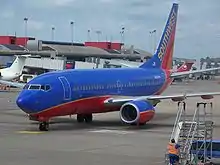
While US Airways made immense cuts in service during the early 21st century, other carriers began to play a more dominant role at PIT. The airport's operator, the Allegheny County Airport Authority, has attempted to attract new service to the airport, particularly low-cost and international carriers. AirTran Airways, which had trouble competing in Pittsburgh after beginning service in 2000, was able to expand Pittsburgh offerings after the US Airways cuts. In 2003, USA3000 Airlines began service to Florida and subsequently expanded to include international destinations in the Caribbean. Southwest Airlines began service to Pittsburgh in May 2005 and broke US Airways's monopolies on Tampa, Phoenix, Las Vegas, and Philadelphia, and brought more competition to the Chicago and Orlando markets. As of March 2017, Southwest served 17 destinations from the airport, more than any other incumbent carrier. JetBlue Airways began service on June 30, 2006, with flights to Boston-Logan and New York-Kennedy, thus in turn breaking US Airways' monopoly on Boston and added more competition to the New York market. Myrtle Beach Direct Air began service in March 2007. Combined increases in competition and diversification of carriers at the airport led to a decline in average airfares by roughly 30%, lowering notoriously high fares once commonplace for the airport.[31] In May 2015, it was announced that Southwest Airlines was looking into expanding in Pittsburgh and possibly designating it as a focus city.[37] In September 2015, Toronto based regional carrier Porter Airlines began daily non-stop service from Pittsburgh to Billy Bishop Toronto City Airport,[38] however the route was discontinued in September 2017.[39]
Pittsburgh has also been successful in attracting ultra low-cost airlines to the region. Allegiant Air commenced service in February 2015 and has been expanding ever since, establishing a base of operations in Pittsburgh on December 24, 2015, and serving nine destinations as of December 2016.[40] Frontier Airlines also began service to five destinations in June 2016, although service was cut back to three destinations just four months later. Spirit Airlines commenced service to seven destinations between May 2017 and July 2017.[41]
In June 2017, WOW air began year-round service to Reykjavik, Iceland, while Condor started seasonal flights to Frankfurt, Germany.[42] The two airlines were the first from Europe to serve Pittsburgh since British Airways halted their service to London in 1999. In November 2018, WOW air announced that flights from Pittsburgh (among others) were currently on hold as it evaluated new operations strategies to address some of its financial difficulties. In January 2019, the airline announced plans to shrink its United States destinations to just four cities (Pittsburgh not being one of them) in order to continue to try to stabilize its finances. In March 2019, WOW air announced its bankruptcy and the immediate termination of all passenger flights, including the permanent end of all Pittsburgh to Iceland flights.
In April 2019, British Airways began nonstop service between Pittsburgh International and London Heathrow Airport, the first time in 20 years that a flight has connected these two cities.[43] Unlike the previous flight to London Gatwick, the flight to London Heathrow landed at a connection-rich British Airways hub. The flight was served with a Boeing 787-8 Dreamliner aircraft.
The airport has also had success in attracting additional domestic flights. Allegiant Air announced new nonstop service to Knoxville.[44] Pittsburgh's growing reputation as a technology focused city also helped secure new connections to other technology hubs: a Delta route to Raleigh-Durham International Airport, a second daily United flight to San Francisco International Airport, and an Alaska Airlines route to Seattle-Tacoma International Airport.[45][46] Contour Airlines entered the Pittsburgh market with a nonstop route to Indianapolis.[47]
From September 5, 2017, non-ticketed persons were allowed to access the airside terminal and gates, similar to pre 9/11 policy. Pittsburgh was the first airport (since 9/11) in the nation to allow non-passengers to pass through security to dine and shop in a post-security terminal. Participants can sign up for myPITpass on the airport's website and must pass through the alternate security checkpoint before continuing through to the Airmall in the airside terminal.[11]
The airport became one of the first in the United States to use a new TSA system called Credential Authentication Technology, which phases out the use of boarding passes at TSA security checkpoints in favor of a stronger system that verifies passengers based solely on a government-issued ID.[48]
In 2020, American Airlines and Republic Airways parked more than 100 planes at Pittsburgh International after the COVID-19 pandemic caused them to cut flights out of their schedules.[49] Airport officials estimated they could store about 140 planes on unused taxiways, runways, deicing pads, and other surfaces.[50] The parked planes included American's Airbus A319, A320, A321, and wide-body A330 aircraft, as well as American's smaller Embraer E-190 Republic's E-170 jets.[51] Also due to the coronavirus, Spirit Airlines began flights between Pittsburgh and Arnold Palmer Regional Airport, about 60 miles away in Latrobe, Pennsylvania, as part of a triangular route to Orlando in order to consolidate passengers going to Orlando onto one flight.[52] Alaska Airlines also modified its nonstop service from Pittsburgh to Seattle to begin in Baltimore, stop in Pittsburgh, and continue to Seattle.[52] The airport became the first US airport to deploy robotic floor scrubbers that use UV-C light to disinfect high-traffic areas.[53] The coronavirus pandemic led to severe drops in traffic from the airport, as much as 95%.[54] It also led to the delay of the airport modernization project.[55]
Future
In September 2017, Allegheny County Airport Authority officials announced a $1.1 billion plan to reconfigure the terminal complex, including a new landside terminal and a new parking garage. Under this proposal, the current landside building would be demolished if another use is not found, and the number of gates be reduced from 75 down to 51. A new landside building would be constructed between the airside terminal's concourses C and D, with new security and baggage facilities, a new international arrivals area, and many other amenities to serve passengers. The board chairman of the Airport Authority, David Minnotte, said that "The people of Pittsburgh finally get an airport built for them and not USAir". No taxpayer dollars would be used to construct the new facility, and it will be instead financed with floating bonds, grants, passenger facility charges, and revenue from natural gas drilling on airport property.[56] Construction was expected to begin in summer 2020 and the new terminal was slated to open in 2023.[57] However, in April 2020 airport officials decided to delay the selling of bonds and start of construction due to the coronavirus pandemic.[55] In February 2021, airport officials announced early site and construction work would begin in spring 2021 with a projected finish in 2024 and opening in 2025.[16]
Facilities
Location
The airport straddles the border between Findlay Township and Moon Township.[58]
Runways
PIT has a wide, open layout and four runways: three east-west parallel runways and a fourth crosswind runway. The airport's two longest runways are 11,500 feet (3,510 m) and 10,775 feet (3,280 m), allowing PIT to accommodate the largest airliners. Because of the development of non-aviation related business on airport land, PIT can add only one more runway (this number was as high as four in the past).
With three parallel runways, simultaneous landings and/or departures can be performed in nearly any situation.[59]
Runways 10L and 10R have Category III ILS (Instrument Landing System) approaches. Runway 28R is certified for Category I ILS and is authorized for Category II approaches but requires special aircrew and aircraft certification. Runways 28L and 32 have Category I ILS approaches and Runways 10C/28C has LOC/GS. All runways have GPS approaches as well.
The 1991 master plan done during the construction of the new midfield terminal for US Airways' hub called for the eventual addition of four runways giving a total of eight. Along with a parallel second "crosswind" runway of 9,000 feet at the southwest corner of the complex, three additional parallel east-west runways of 8,200 and 8,500 feet were to be built on the southern end of the complex with an 8,200-foot runway on the northwest section.[60]
With the latest construction at the airport, Runway 10C/28C was extended to 10,775 feet.[61]
Terminal
The airport complex consists of two main buildings, the "Landside Terminal" and the "Airside Terminal". They are linked by the Pittsburgh airport underground people mover after the security checkpoint. It is run fully by computers with no human control aside from emergencies.
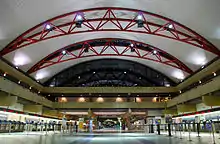
The landside terminal is the building closer to the parking areas and the entry point for passengers whose flights originate from Pittsburgh. It includes ticketing, all domestic baggage claim areas, security checkpoints, and ground transportation such as taxi, limo, and the Port Authority's 28X airport shuttle. A 331-room Hyatt Regency hotel/convention center opened on June 29, 2000, and is directly attached via moving walkway to the terminal.[62] Several shops and cafes occupy the Landside Terminal including Travelmart, Sue Venir, Dunkin Donuts, and Travelex currency services. There are Travelers Aid desks on the transit and baggage claim levels as well as Airport Police Headquarters.
After passing through the security checkpoint, passengers board one of two underground people movers that travel to the Airside Terminal, where all departure gates are located. The people mover system was built and operated by Bombardier Transportation and is completely controlled by computer.
The current landside terminal will be replaced in 2023 with an (estimated) US$1.1 billion landside terminal connected directly to the airside terminal where concourses C & D are. This will eliminate 12 gates from the airport. This will result in the elimination of the people mover and the construction of new parking.[63]
The Airside Terminal consists of 75 gates on four concourses; however, only 56 gates are available for use.[64] The center core contains the majority of the AirMall shops. There are over 100 shops. On the mezzanine level are the Admirals Club and a chapel. There are also Carnegie Science Center and other historic sites Pittsburgh Aviation History Displays located throughout the airport. American Airlines has an Admirals Club on the mezzanine level of the airside terminal.[65] The Club Lounge opened in October 2017 and is located in the C Concourse across from gate C-52 near the center core.[66]
Concourse A has 25 gates. The concourse is used by Air Canada, Boutique Air, Southwest, United and United Express, as well as Delta for charter flights and overnighting aircraft. There are multiple food and beverage concessions on the concourse.
Concourse B has 25 gates; however, only gates B26-B44 are available for use. Concourse B is used by Alaska Airlines, American, American Eagle, JetBlue, Southern Airways Express, and Spirit. Several concessionaires still operate in the concourse.
Concourse C has 11 gates. All international arrivals, except for cities with United States border preclearance, pass through Concourse C as customs and immigration is located on its lower level. Although this is the International Concourse, some domestic flights go in and out of Concourse C. Gates C55 and C57–C61 at the end of the concourse are designated to accommodate international traffic. Gate C61 includes a dual jetway to accommodate widebody aircraft such as the Airbus A380, but it had been designed for British Airways' Boeing 747, and the Airbus A330. The concourse also includes a children's play area, and an exhibit commemorating Mister Rogers' Neighborhood, the long-running public television series that originated from Pittsburgh.[67] Concourse C is utilized by Allegiant Air, British Airways, Condor, Sunwing, Swift Air, and VivaAerobús for all flights, as well as Delta and Southwest for international flights. The airport's military lounge is located before gate C56.
Concourse D has 14 gates; however, only 7 gates are in use. In November 2019, the airport began removal of seven jet bridges to accommodate the eventual construction of the Terminal Modernization Program. Concourse D is used by Delta, Delta Connection, and Frontier.
Ground transportation
PIT is located at Exit 53 of Interstate 376 and the Western Terminus Pennsylvania Route 576 (future I-576), and within 10 miles (20 km) of Interstate 79 and 15 miles (24 km) of Interstate 76, the Pennsylvania Turnpike. Interstate 70 to the south and Interstate 80 to the north are both less than an hour away. Just beyond Interstates 70 and 80, Interstate 77 to the west and Interstate 68 to the south are within 90 minutes of the airport.
PIT offers on-site parking operated by the Grant Oliver Corporation and patrolled by the Allegheny County Police. Grant Oliver offers usage of a GO FAST Pass account to pay for parking electronically at the airport. Go Fast Pass customers may register their E-Zpass transponders to use with the system, although billing and other aspects of the system are entirely handled by Grant Oliver.[68] There are regular parking shuttles to the Long Term and Extended lots[69] that can be accessed from the Baggage Claim level of the Landside Terminal outside doors six and eight.
There are three options for parking: Short Term, Long Term, and Extended. The Short Term garage is attached to the Landside Terminal via the enclosed moving walkway. There are 2,100 spaces available. The Long Term section also has quick access to the enclosed moving walkway. There are 3,100 spaces available here. The Extended section does not have access to the enclosed moving walkway but does have regular parking shuttles that can be accessed from the Baggage Claim level of the Landside Terminal outside doors six and eight. There are 8,000 spaces available in the Extended lot.[69]
Bus service is also available from Downtown Pittsburgh and the city's University District (Oakland) via the Port Authority of Allegheny County's 28X Route. Mountain Line Transit's Grey Line also has service to areas south of Pittsburgh including Waynesburg, Pennsylvania; Morgantown, Fairmont, and Clarksburg, West Virginia.[70] BCTA Transit formerly served locations north and westbound from the airport.
Other operations and property development
Aside from commercial flights, other resources in and around the airport have been developed. In November 2008, the airport, helped by the volunteer ambassadors, opened a new Military Comfort Center at Gate A4 to serve traveling military and their families. Dick's Sporting Goods constructed a new global headquarters and hangar on the airport complex in early 2010.[71] A major logistics center was constructed and opened in 2010.[72]
Since 1997, US Airways maintained its OpsCenter in the metro Pittsburgh area. After the merger with America West the airline had two centers both with limited (pre-merger) capacity, the other being America West's inherited center near Phoenix. Pittsburgh International won a three-way competition between Phoenix and Charlotte for the new combined airlines state of the art operations center.
In October 2007, US Airways announced that it had selected Pittsburgh as the site of its new 60,000 sq ft (5,600 m2) flight operations center, which serves as the nerve center of the airline's 1,400 daily mainline flights.[73] The $25 million ($29.7 million present day dollars), 72,000-square-foot (6,700 m2) facility on a far corner of Airport property began operations in November 2008. With a staff of over 600 specialists, it coordinated all arrivals, departures and inflight services in the global US Airways system 24 hours a day, seven days per week. The center has since relocated to Dallas/Ft. Worth.[74]
Airlines and destinations
Passenger
Cargo
Pittsburgh International Airport has a sizeable freight business, with a Free-trade zone of 5,000 acres (20 km2), access to three class-one railroad freight lines, one interstate highway, and a location a few miles from the nation's second largest inland port.[88] The airport's three largest cargo carriers account for over 100 million pounds (45 million kg) of freight per year.[89] Three cargo buildings provide more than 183,000 square feet (17,001 m2) of warehouse capacity and over 450,000 square feet (41,806 m2) of apron space.[90]
LogisticsCentre, a master planned industrial park at the intersection of Business Route 60 and International Drive, is a 440-acre (1.8 km2) North Field site to contain 900,000 square feet (84,000 m2) of Class A warehouse, distribution and air cargo space. Current tenants include Dick's Sporting Goods new world headquarters. It is located within Foreign Trade Zone No. 33.
In 2019, PIT received a $18.69 million grant from the U.S. Department of Transportation to construct a new cargo processing facility and expand cargo operations at PIT.[91] In 2020, National Air Cargo landed five FEMA charter flights at PIT carrying medical supplies for the coronavirus pandemic from South Korea.[92] Also in 2020, the airport announced an agreement with Ted Stevens Anchorage International Airport, the fifth-busiest cargo airport in the world, to boost sales and marketing efforts at both airports, with an emphasis on cargo.[92]
Construction of a $6.75 million (present-day dollars) cargo complex began at the airport in 1987.[93]
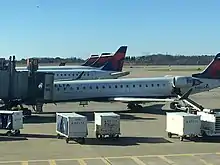
| Airlines | Destinations |
|---|---|
| FedEx Express | Indianapolis, Memphis, Newark |
| FedEx Feeder | State College[94] |
| Qatar Airways Cargo | Doha[95] |
| UPS Airlines | Louisville, Philadelphia |
International food cargo hub
The world's leading caterer for air and business, LSG SkyChefs, in 2007 chose Pittsburgh as its sole Western Hemisphere manufacturing facility. It expanded its customer service center on the cargo side of the airport by 20,000 square feet (1,900 m2) and now employs over 100 people with the capacity of making nearly 25 million meals per year for distribution to flights all over the Americas.[96] LSG SkyChefs cited the region's strategic location for air and truck transport to major suppliers and customers, as well as the airport's excellent record in maintaining and expanding capacity.
Statistics
Top destinations
| Rank | City | Passengers | Carriers |
|---|---|---|---|
| 1 | Atlanta, Georgia | 215,000 | Delta, Southwest |
| 2 | Charlotte, North Carolina | 176,000 | American |
| 3 | Orlando, Florida | 153,000 | Frontier, Southwest, Spirit |
| 4 | Chicago–O'Hare, Illinois | 136,000 | American, United |
| 5 | Denver, Colorado | 116,000 | Frontier, Southwest, United |
| 6 | Dallas/Fort Worth, Texas | 101,000 | American |
| 7 | Fort Lauderdale, Florida | 89,000 | JetBlue, Southwest, Spirit |
| 8 | Tampa, Florida | 78,000 | Southwest, Spirit |
| 9 | Boston, Massachusetts | 71,000 | Delta, JetBlue |
| 10 | Chicago–Midway, Illinois | 71,000 | Southwest |
Airline market share
| Rank | Airline | Passengers | Share |
|---|---|---|---|
| 1 | Southwest Airlines | 1,208,000 | 26.84% |
| 2 | American Airlines | 671,000 | 14.90% |
| 3 | Republic Airways | 552,000 | 12.28% |
| 4 | Delta Airlines | 417,000 | 9.27% |
| 5 | Spirit Airlines | 415,000 | 9.23% |
Annual traffic
| Year | Passengers | Year | Passengers |
|---|---|---|---|
| 2003 | 14,266,984 | 2013 | 7,884,170 |
| 2004 | 13,271,709 | 2014 | 7,998,970 |
| 2005 | 10,478,605 | 2015 | 8,128,187 |
| 2006 | 9,987,310 | 2016 | 8,309,754 |
| 2007 | 9,822,588 | 2017 | 8,988,016 |
| 2008 | 8,710,291 | 2018 | 9,658,897 |
| 2009 | 8,031,175 | 2019 | 9,779,024[104] |
| 2010 | 8,195,359 | 2020 | 3,649,270 |
| 2011 | 8,300,310 | 2021 | |
| 2012 | 8,041,357 | 2022 |
Accidents and incidents
| Date | Airline | Aircraft type | Description |
| July 28, 2011 | U.S. Army | Lockheed Martin "HALE-D" | An unmanned U.S. Army/Lockheed Martin experimental "HALE-D" airship that took off at 5 am at Wright Patterson Air Force Base crash landed from 32,000 feet at 8:30 am south of the airport between New Freeport and Gilmore.[105] |
| November 22, 2001 | Corporate | Learjet | Crashed after a rapid takeoff in which it went "nose-high" before the Pilot Flying (PF) lost control, both on board were killed.[106][107] |
| September 8, 1994 | USAir Flight 427 | Boeing 737-300 | Crashed on approach from Chicago O'Hare International Airport. All 132 people on board were killed. It resulted in the longest and most thorough NTSB investigation in history. It was determined that a lock occurred in rudder control that caused the plane to fall uncontrollably from 6,000 feet (1,800 m). Boeing has retrofitted every 737 because of the data gathered from this crash. The plane crashed roughly 10 miles (16 km) North-Northwest in Hopewell Township. |
| July 31, 1969 | Trans World Airlines Flight 79 | Boeing 727 | The plane was hijacked en route from Pittsburgh to Los Angeles International Airport by bank robber Lester Perry Jr. who was being transferred to a new prison. Though accompanied by a U.S. marshal and a correctional officer, Perry was allowed to go to the lavatory unaccompanied where he found a razor blade. He then held hostage a flight attendant and demanded to be taken to Havana, Cuba. Upon landing at José Martí International Airport he sought political asylum from the Cuban government.[108] |
| April 1, 1956 | TWA Flight 400 | Martin 4-0-4 | This was a flight from Pittsburgh to Newark. It crashed about a half-mile after taking off when the Captain and First Officer did not immediately correct a small engine malfunction/fire. Due to miscommunication and lack of focus it caused failure and a crash. Twenty-two of 36 occupants were killed.[109] |
| February 19, 1956 | US Air Force | Republic F-84F Thunderstreak | A Republic F-84F Thunderstreak crashed into a field behind Holy Trinity Church after an engine flameout during a training flight. The pilot, Thomas W. Sonnett, did not eject because he feared his aircraft would cause ground fatalities. After the crash, he was pulled from the jet and rushed to Ohio Valley General Hospital, where he died from his injuries. He was just 32 years old. |
| January 31, 1956 | U.S. Air Force | B-25 Mitchell | North American TB-25N Mitchell 44-29125, on cross country flight from Nellis AFB, Nevada to Olmsted AFB, Pennsylvania, after departing Selfridge AFB, Michigan suffers fuel starvation NE of Pittsburgh, Pennsylvania in mid-afternoon, attempts to divert to Greater Pittsburgh AFB, ditches in the Monongahela River at the 4.9-mile (7.9 km) marker, west of the Homestead High-Level Bridge, drifts ~1.5 miles (2.4 km) downstream in 8–10 knots. current, remaining afloat for 10–15 minutes. All six crew evacuate but two are lost in the 35 °F (2 °C) water before rescue. Search for sunken bomber suspended February 14 with no success – aircraft is thought to have possibly settled in submerged gravel pit area in 32 feet (9.8 m) of water, ~150 feet (46 m) from shore, possibly now covered by 10–15 feet of silt. This crash remains one of the Pittsburgh region's unsolved mysteries.[110] |
| December 22, 1954 | Military Charter | Douglas DC-3 | Ditched in the Monongahela River with 28 men on board after the pilot reported running out of fuel. 10 perished.[111] |
| July 13, 1950 | Private | Beechcraft Commander | Two killed and one injured in a crash at Montour Country Club after engine failure.[112] |
See also
References
- Fontaine, Tom. "Pittsburgh adding flights to regional airports". TribLIVE.com.
- "PIT Aiport - Summary Of Traffic December 2020" (PDF). flypittsbugh.com. December 1, 2020. Retrieved January 27, 2021.
- FAA Airport Form 5010 for PIT PDF, effective March 15, 2007
- 2010 North American final rankings Archived March 16, 2012, at the Wayback Machine
- "PIT Aiport - Summary Of Traffic December 2020" (PDF). flypittsbugh.com. December 1, 2020. Retrieved January 27, 2021.
- Pittsburgh Builds Airport of Future Now
- Pittsburgh to be first airport to allow non-fliers past security since 9/11
- Pittsburgh International Airport considers abandoning $1B terminal's landside building, tram
- The Revival of a Once-Bustling Airport
- Promises made and broken: Picking up the pieces left by US Airways’ departure from Pittsburgh
- "Non-flyers will have access to Airmall at Pittsburgh International Airport". Pittsburgh Post-Gazette. Retrieved April 16, 2019.
- American adds 5 years to deal for maintenance hangars at Pittsburgh airport
- Pittsburgh International Airport’s $1.1B project prepares for takeoff
- A US Airways airport no more? New vision unveiled for Pittsburgh's airport
- Pittsburgh's airport shows off plans for new $1.1 billion terminal
- Pittsburgh International Airport ready to 'move ahead' with $1.1B Terminal Modernization Program
- "PIT TRAFFIC REPORT AUGUST 2015: NEW FLIGHTS ON VACATION EXPRESS, ALLEGIANT, SOUTHWEST CONTRIBUTE TO GROWTH - PIT". Archived from the original on October 20, 2015.
- Belko, Mark (September 28, 2010). "Southwest's bid to buy AirTran could bump US Airways as dominant carrier". Pittsburgh Post-Gazette. Retrieved October 4, 2010.
- "Delta Plans Trans-Atlantic Service Between Paris and Raleigh-Durham, Pittsburgh". Atlanta, Georgia: Delta Air Lines. November 6, 2008. Retrieved July 12, 2009.
- "Delta ending Pittsburgh-to-Paris flights this summer". August 22, 2018. Retrieved January 27, 2019.
- Belko, Mark (November 10, 1999). "Pittsburgh International Airport ranked world's third best". Pittsburgh Post-Gazette. Retrieved July 12, 2009.
- "Business Travelers Rank PIT 7th Best Overall U.S. Airport". Allegheny County Airport Authority. March 7, 2011. Archived from the original on April 7, 2012. Retrieved November 20, 2011.
- "The Pittsburgh Press - Google News Archive Search". The Pittsburgh Press.
- "Pittsburgh Post-Gazette - Google News Archive Search".
- "Pittsburgh Post-Gazette - Google News Archive Search".
- "Pittsburgh Post-Gazette - Google News Archive Search".
- "Pittsburgh Post-Gazette - Google News Archive Search".
- "TKA Architects, Inc".
- Pittsburgh International Airport Cargo and Passenger History, 1980–2003. Archived March 4, 2016, at the Wayback Machine Allegheny County Airport Authority.
- "Pittsburgh International Airport's midfield terminal at 20: A shell of its past self – Pittsburgh Post-Gazette". Post-gazette.com. September 30, 2012. Retrieved July 5, 2013.
- David Grossman, "Dismantling Pittsburgh: Death of an airline hub.", USA Today, October 15, 2007; Retrieved November 6, 2011.
- "Pittsburgh airport objects to US Airways plan", Charlotte Business Journal, published August 3, 2011, retrieved November 6, 2011.
- "US Airways: Pittsburgh hub worth 17,000 jobs", Charlotte Business Journal, September 17, 2003; retrieved November 6, 2011.
- Dan Fitzpatrick, "Pittsburgh Given Little Chance to Regain Hub Status", Pittsburgh Post-Gazette, p. A8, May 20, 2005; Retrieved November 6, 2011.
- "US Airways to cut Pittsburgh service". Charlotte Business Journal. October 3, 2007. Retrieved November 7, 2011.
- Belko, Mark (November 11, 2007). "Silence is deafening in airport concourses". Pittsburgh-Post Gazette. Retrieved July 12, 2009.
- "Southwest Airlines looking at possible expansion in Pittsburgh". Pittsburgh Post-Gazette.
- "New Pittsburgh-to-Toronto flight options coming in September".
- "Toronto airline to drop flights from Pittsburgh airport". Pittsburgh Post-Gazette. Retrieved September 30, 2019.
- "Allegiant Air is making Pittsburgh a base of operations". Pittsburgh Post-Gazette.
- Belko, Mark (February 21, 2017). "Spirit Airlines to launch flights from Pittsburgh International Airport". Pittsburgh Post-Gazette. Retrieved February 21, 2017.
- "Airline to offer nonstop service from Pittsburgh to Frankfurt".
- "British Airways coming to Pittsburgh, will fly to London Heathrow". USA TODAY. Retrieved April 16, 2019.
- O'Toole, Bill (April 8, 2019). "Check out the latest direct flights from Pittsburgh International Airport". NEXTpittsburgh. Retrieved April 16, 2019.
- "United expanding local service to San Francisco". www.bizjournals.com. Retrieved April 16, 2019.
- "Alaska Airlines to fly the only nonstop flight from Seattle to Pittsburgh". newsroom.alaskaair.com. Retrieved September 21, 2019.
- Nonstop Flight From Pittsburgh To Indianapolis Coming To Pittsburgh International
- Pittsburgh airport to phase out using boarding passes at security checkpoints
- Parked Planes Stack Up at U.S. Airports
- Pittsburgh International housing more than 100 grounded planes in its airfield
- Cleared for landing: Grounded planes crowd Pittsburgh International airfield
- With Low Passenger Counts, Airlines Concocting Odd Routes
- PIT First U.S. Airport to Deploy Ultraviolet Cleaning – By Robots
- A ‘pretty eerie and unsettling time’: Airport traffic collapses in the wake of COVID-19
- Airport's $1.1B terminal modernization delayed
- "$1.1B approved for reconfiguration of Pittsburgh International, including new landside terminal". Pittsburgh Post-Gazette. September 12, 2017.
- Site work for $1.1 billion airport modernization to start in April
- Findlay files suit against county over Pittsburgh International Airport's water supply
- "Pittsburgh International Airport" (PDF). Federal Aviation Administration. April 2009. Archived from the original (PDF) on November 4, 2008. Retrieved July 12, 2009.
- Greater Pittsburgh International Airport – Airport Capacity Enhancement Plan (PDF) (Report). October 1991. Archived from the original (PDF) on March 18, 2004.
- "Pittsburgh International Airport". AirportIQ 5010. June 2013. Retrieved June 28, 2013.
- "Hyatt Regency Pittsburgh Airport website".
- Fontaine, Theresa Clift and Tom. "Pittsburgh International Airport's $1.1B project prepares for takeoff". TribLIVE.com.
- "Terminal Maps - PIT". Archived from the original on October 11, 2014. Retrieved November 7, 2011.
- "Pittsburgh, PA (PIT)". American Airlines. Retrieved November 3, 2015.
- "Book your day pass for The Club airport lounge at Pittsburgh International Airport". shop.theclubairportlounges.com.
- "Mister Rogers back at Pittsburgh Int’l Airport" Stuck at the Airport, published February 24, 2009, retrieved March 17, 2012.
- "Go Fast Pass". Grant Oliver Corporation. 2007. Archived from the original on July 13, 2009. Retrieved July 12, 2009.
- "PIT – Parking : Onsite Parking Guide". Allegheny County Airport Authority. March 25, 2009. Archived from the original on June 6, 2009. Retrieved July 12, 2009.
- "Grey Line". MountainLine Transit. Retrieved February 17, 2010.
- Dick's Sporting Goods opens expansive $150M corporate headquarters by airport Archived February 3, 2016, at the Wayback Machine. Retrieved November 5, 2011 from Pop City Media.
- "Onorato & Airport Authority Officials Break Ground on New Development at PIT's North Field Site". Allegheny County Airport Authority. March 25, 2009. Archived from the original on June 6, 2009. Retrieved July 12, 2009.
- Fitzpatrick, Dan (February 21, 2007). "Pittsburgh lands US Airways operations center". Pittsburgh-Post Gazette. Retrieved November 6, 2011.
- "Quantified Stock Market Trading Strategies & Systems - TradingMarkets…". Archived from the original on February 4, 2013.
- "Flight Schedules". Retrieved January 7, 2017.
- "Flight timetable". Retrieved April 6, 2020.
- https://ir.allegiantair.com/news-releases/news-release-details/allegiant-announces-major-service-expansion-21-new-nonstop
- https://www.allegiantair.com/interactive-routemap
- "Flight schedules and notifications". Retrieved January 7, 2017.
- Randy Griffith (August 23, 2018). "Boutique Air chosen to serve Johnstown airport". The Tribune-Democrat.
- "FLIGHT SCHEDULES". Retrieved January 7, 2017.
- "Frontier". Retrieved June 18, 2019.
- "JetBlue Airlines Timetable". Retrieved January 29, 2017.
- "Destinations". Retrieved January 7, 2017.
- "Southwest Airlines - Check Flight Schedules". Retrieved November 10, 2018.
- "Where We Fly". Retrieved January 29, 2017.
- "Timetable". Retrieved January 7, 2017.
- "Onorato, Airport Authority Announce Letter of Intent with Xian Xianyang International Airport for Air Cargo Development". Allegheny County Airport Authority. November 15, 2007. Archived from the original on September 28, 2011. Retrieved November 20, 2011.
- "Pittsburgh International Airport: Fact Sheet". Allegheny County Airport Authority. March 25, 2009. Archived from the original on July 13, 2009. Retrieved July 12, 2009.
- "Worldwide Flight Services Cargo Handling Facilities at PIT Receives TSA Certification". Allegheny County Airport Authority. June 12, 2009. Archived from the original on April 7, 2012. Retrieved November 20, 2011.
- Feds Give PIT Cargo Operation $18 Million Boost
- Pittsburgh, Anchorage Airports Boost Cargo Connection
- Blazina, Ed (April 17, 1987). "RIDC asked to develop cargo building". Pittsburgh Press. Pittsburgh, PA.
- "Wiggins #8463 ✈ 29-Sep-2018 ✈ KPIT - KUNV ✈ FlightAware".
- https://www.bizjournals.com/pittsburgh/news/2020/12/04/qatar-airways-returns-service-at-pit.html
- "Airport Authority and LSG Sky Chefs Announce Opening of New Frozen Food Facility Located at PIT". Allegheny County Airport Authority. June 4, 2008. Archived from the original on September 28, 2011. Retrieved November 20, 2011.
- "RITA - BTS - Transtats". Bureau of Transportation Statistics. Retrieved November 29, 2020.
- Pittsburgh International Airport, . Accessed April 6, 2018.
- "Airport Statistics - PIT". Archived from the original on March 20, 2015.
- "Comprehensive Annual Financial Report for the Years Ended December 31, 2013 and 2012 (pg 91). Retrieved on Mar 29, 2015" (PDF). Archived from the original (PDF) on September 24, 2015.
- "Comprehensive Annual Financial Report for the Years Ended December 31, 2012 (pg 88). Retrieved on Mar 29, 2015" (PDF). Archived from the original (PDF) on September 24, 2015.
- "2016 BUSIEST YEAR IN NEARLY A DECADE; INCREASED TRAFFIC CONTRIBUTING TO FINANCIAL STABILITY. Retrieved on Jan 20, 2017".
- "Passenger traffic at Pittsburgh International Airport up 8.2 percent in 2017" (Press release). Pittsburgh International Airport. January 19, 2018. Retrieved January 19, 2018.
- "Pittsburgh International Airport – Summary of Airline Traffic – December 2019" (PDF). Pittsburgh International Airport. February 25, 2020.
- "Blimp experiment falls flat". Pittsburgh Post-Gazette.
- Ricks, Linda (May 29, 2008). "Learjet crashes on takeoff". Aviation International News. Retrieved October 24, 2013.
- "Accident description". Retrieved October 24, 2013.
- Michael Newton (2002). The Encyclopedia of Kidnappings. Infobase Publishing. p. 226. ISBN 978-1-4381-2988-4.
- "Accident Synopsis 04011956". AirDisaster.com. Archived from the original on October 17, 2015.CS1 maint: unfit URL (link)
- D'Costa, Ian (May 12, 2015). "The Ghost Bomber of the Monongahela River". tacairnet.com. The Tactical Air Network. Retrieved September 12, 2015.
- "Pittsburgh, PA Plane Crashes Into River, Dec 1954". Archived from the original on September 21, 2012. Retrieved November 15, 2011.
- "Pittsburgh, PA Private Plane Crash, July 1950".
External links
| Wikimedia Commons has media related to Pittsburgh International Airport. |
| Wikivoyage has a travel guide for Pittsburgh. |
- FlyPittsburgh.com official site
- PennDOT Bureau of Aviation: Pittsburgh International Airport
- Airmall
- FAA Airport Diagram (PDF), effective January 28, 2021
- Resources for this airport:
- AirNav airport information for KPIT
- ASN accident history for PIT
- FlightAware airport information and live flight tracker
- NOAA/NWS weather observations: current, past three days
- SkyVector aeronautical chart for KPIT
- FAA current PIT delay information
